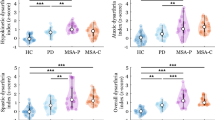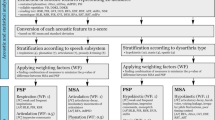Abstract
Although speech disorder is frequently an early and prominent clinical feature of Parkinson’s disease (PD) as well as atypical parkinsonian syndromes (APS) such as progressive supranuclear palsy (PSP) and multiple system atrophy (MSA), there is a lack of objective and quantitative evidence to verify whether any specific speech characteristics allow differentiation between PD, PSP and MSA. Speech samples were acquired from 77 subjects including 15 PD, 12 PSP, 13 MSA and 37 healthy controls. The accurate differential diagnosis of dysarthria subtypes was based on the quantitative acoustic analysis of 16 speech dimensions. Dysarthria was uniformly present in all parkinsonian patients but was more severe in PSP and MSA than in PD. Whilst PD speakers manifested pure hypokinetic dysarthria, ataxic components were more affected in MSA whilst PSP subjects demonstrated severe deficits in hypokinetic and spastic elements of dysarthria. Dysarthria in PSP was dominated by increased dysfluency, decreased slow rate, inappropriate silences, deficits in vowel articulation and harsh voice quality whereas MSA by pitch fluctuations, excess intensity variations, prolonged phonemes, vocal tremor and strained-strangled voice quality. Objective speech measurements were able to discriminate between APS and PD with 95 % accuracy and between PSP and MSA with 75 % accuracy. Dysarthria severity in APS was related to overall disease severity (r = 0.54, p = 0.006). Dysarthria with various combinations of hypokinetic, spastic and ataxic components reflects differing pathophysiology in PD, PSP and MSA. Thus, motor speech examination may provide useful information in the evaluation of these diseases with similar manifestations.

Similar content being viewed by others
References
Schrag A, Ben-Shlomo Y, Quinn NP (1999) Prevalence of progressive supranuclear palsy and multiple system atrophy: a cross-sectional study. Lancet 354:1771–1775
Wenning GK, Litvan I, Tolosa E (2011) Milestones in atypical and secondary Parkinsonisms. Mov Disord 26:1083–1095
Berti V, Pupi A, Monsconi L (2011) PET/CT in diagnosis of movement disorders. Ann N Y Acad Sci 1228:93–108
Tang CC, Poston KL, Eckert T, Feigin A, Frucht S et al (2010) Differential diagnosis of parkinsonism: a metabolic imaging study using pattern analysis. Lancet Neurol 9:149–158
Rusz J, Cmejla R, Ruzickova H, Klempir J, Majerova V et al (2011) Acoustic assessment of voice and speech disorders in Parkinson’s disease through quick vocal test. Mov Disord 26:1951–1952
Ho AK, Iansek R, Marigliani C, Bradshaw J, Gates S (1998) Speech impairment in large sample of patients with Parkinson’s disease. Behav Neurol 11:131–137
Kluin KJ, Foster NL, Berent S, Gilman S (1993) Perceptual analysis of speech disorders in progressive supranuclear palsy. Neurology 43:563–566
Kluin KJ, Gilman S, Lohman M, Junck L (1996) Characteristics of the dysarthria in multiple system atrophy. Arch Neurol 53:545–548
Kim Y, Kent RD, Kent J, Duffy JR (2010) Perceptual and acoustic features of dysarthria associated with multiple system atrophy. J Med Speech Lang Pathol 18:66–70
Rusz J, Cmejla R, Ruzickova H, Ruzicka E (2011) Quantitative acoustic measurements for characterization of speech and voice disorders in early untreated Parkinson’s disease. J Acoust Soc Am 129:350–369
Rusz J, Cmejla R, Tykalova T, Ruzickova H, Klempir J et al (2013) Imprecise vowel articulation as a potential early marker of Parkinson’s disease: effect of speaking task. J Acoust Soc Am 134:2171–2181
Rusz J, Megrelishvili M, Bonnet C, Okujava M, Brozova H et al (2014) A distinct variant of mixed dysarthria reflects parkinsonism and dystonia due to ephedrone abuse. J Neural Transm 121:655–664
Sachin S, Shukla G, Goyal V, Singh S, Aggarwal V et al (2008) Clinical speech impairment in Parkinson’s disease, progressive supranuclear palsy, and multiple system atrophy. Neurol India 56:122–126
Skodda S, Visser W, Schlegel U (2011) Acoustical analysis of speech in progressive supranuclear palsy. J Voice 25:725–731
Saxena M, Behari M, Kumaran SS, Goyal V, Narang V (2014) Assessing speech dysfunction using BOLD and acoustic analysis in parkinsonism. Parkinsonism Relat D 20:855–861
Litvan I, Agid Y, Calne D, Campbell G, Dubois B et al (1996) Clinical research criteria for the diagnosis of progressive supranuclear palsy (Steele–Richardson–Olszewski syndrome): report of the NINDS-SPSS international workshop. Neurology 47:1–9
Gilman S, Wenning GK, Low PA, Brooks DJ, Mathias CJ et al (2008) Second consensus statement on the diagnosis of multiple system atrophy. Neurology 71:670–676
Hughes AJ, Daniel SE, Kilford L, Lees AJ (1992) Accuracy of clinical diagnosis of idiopathic Parkinson’s disease: a clinico-pathological study of 100 cases. J Neurol Neurosurg Psychiatry 55:181–184
Payan CA, Viallet F, Landwerhrmeyer BG, Bonnet AM, Borg M et al (2011) Disease severity and progression in progressive supranuclear palsy and multiple system atrophy: validation of the NNIPPS-Parkinson plus scale. PLoS One 6:e22293
Duffy JR (2013) Motor Speech Disorders: Substrates, Differential Diagnosis and Management, 3rd edn. Mosby, St. Louis
Darley FL, Aronson AE, Brown JR (1969) Differential diagnostic patterns of dysarthria. J Speech Hear Res 12:246–269
Novotny M, Rusz J, Cmejla R, Ruzicka E (2014) Automatic evaluation of articulatory disorders in Parkinson’s disease. IEEE/ACM T Audio Speech Lang Process 22:1366–1378
Hartelius L, Gustavsson H, Astrand M, Holmberg B (2006) Perceptual analysis of speech in multiple system atrophy and progressive supranuclear palsy. J Med Speech Lang Pathol 14:241–247
Liss JM, Spitzer SM, Caviness JN, Adler C (2002) The effect of familiarization on intelligibility and lexical segmentation in hypokinetic and ataxic dysarthria. J Acoust Soc Am 112:3022–3030
Benke T, Hohenstein C, Poewe W, Butterworth B (2000) Repetitive speech phenomena in Parkinson’s disease. J Neurol Neurosurg Psychiatry 69:319–325
Nath U, Ben-Shlomo Y, Thomson RG, Lees AJ, Burn DJ (2003) Clinical features and natural history of progressive supranuclear palsy: a clinical cohort study. Neurology 69:910–916
Nebel A, Reese R, Deuschl G, Mehdorn HM, Volkmann J (2009) Acquired stuttering after pallidal deep brain stimulation for dystonia. J Neural Transm 116:167–169
Neef NE, Hoang TNL, Neef A, Paulus W, Sommer M (2015) Speech dynamics are coded in the left motor cortex in fluent speakers but not in adults who stutter. Brain. doi:10.1093/brain/awu390 (in press)
Tykalova T, Rusz J, Cmejla R, Klempir J, Ruzickova H, et al (2015) Effect of dopaminergic medication on speech dysfluency in Parkinson’s disease: a longitudinal study. J Neural Transm: in press. doi:10.1007/s00702-015-1363-y
Louis ED, Winfield L, Fahn S, Ford B (2001) Speech dysfluency exacerbated by levodopa in Parkinson’s disease. Mov Disord 16:562–565
Ostock CY, Dupre KB, Jaunarajs KL, Walters H, George J et al (2011) Role of the primary motor cortex in L-Dopa-induced dyskinesia and its modulation by 5-HT1A receptor stimulation. Neuropharmacology 61:753–760
Rusz J, Klempir J, Tykalova T, Baborova E, Cmejla R et al (2014) Characteristics and occurrence of speech impairment in Huntington’s disease: possible influence of antipsychotic medication. J Neural Transm 121:655–664
Gilman S, Wenning GK, Low PA, Brooks DJ, Mathias CJ et al (2001) Second consensus statement on the diagnosis of multiple system atrophy. Neurology 71:670–676
Kluin KJ, Gilman S, Foster NL, Sima AAF, D’Amato CJ et al (2001) Neuropathological correlates of dysarthria in progressive supranuclear palsy. Arch Neurol 58:265–269
Prodoehl J, Li H, Planetta JP, Goetz CG, Shannon KM, Tangonan R et al (2013) Diffusion Tensor Imaging of Parkinson’s disease, atypical parkinsonism, and essential tremor. Mov Disord 28:1816–1822
Nakleh MK, Badarny S, Winer R, Jeries R, Finberg J, Haick H. (2015) Distinguishing idiopathic Parkinson’s disease from other parkinsonian syndromes by breath test. Parkinsonism Relat D. doi:10.1016/j.parkreldis.2014.11.023 (in press)
Ho AK, Bradshaw R, Iansek R (2008) For better or worse: the effect of levodopa on speech in Parkinson’s disease. Mov Disord 23:575–580
Acknowledgments
This study was supported by the Czech Ministry of Health (NT 12288-5).
Conflicts of interest
The authors report no conflicts of interest.
Ethical standard
Each participant provided written, informed consent. The study was approved by the Ethics Committee of the General University Hospital in Prague, Czech Republic, and have therefore been performed in accordance with the ethical standards laid down in the 1964 Declaration of Helsinki.
Author information
Authors and Affiliations
Corresponding author
Electronic supplementary material
Below is the link to the electronic supplementary material.
Rights and permissions
About this article
Cite this article
Rusz, J., Bonnet, C., Klempíř, J. et al. Speech disorders reflect differing pathophysiology in Parkinson’s disease, progressive supranuclear palsy and multiple system atrophy. J Neurol 262, 992–1001 (2015). https://doi.org/10.1007/s00415-015-7671-1
Received:
Revised:
Accepted:
Published:
Issue Date:
DOI: https://doi.org/10.1007/s00415-015-7671-1




